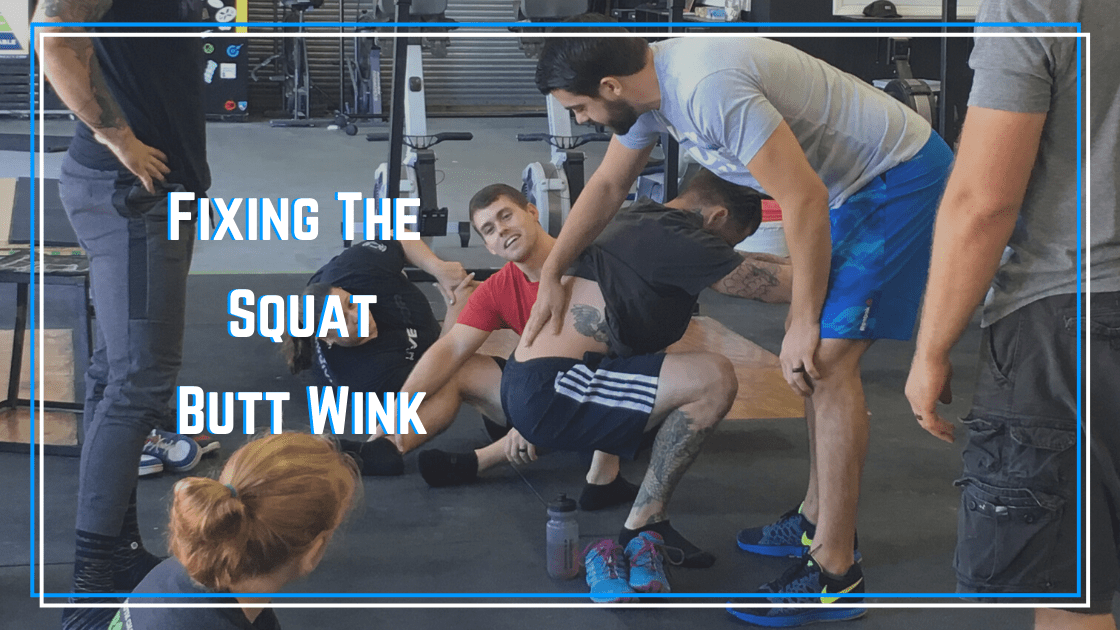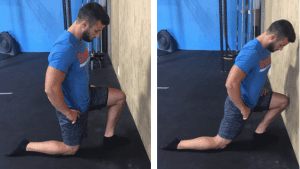The term squat butt wink refers to an athlete’s low back rounding as they reach the bottom position of their squat. Often, this is considered a movement fault as some low back injuries can occur when the low back rounds under heavy loads. If you are dealing with squat butt wink issues, then there few treatment strategies that can help improve your movement.
Note: there is a normal amount of unavoidable lumbar flexion that occurs as everyone squats. I only consider addressing it when there is significant rounding, OR the athlete comes to main with pain brought on by flexing their spine under load. It is also important to note that I do not believe flexing your back without heavy loads is dangerous. But, at a certain point in loading, I do think we become safer when we try to stay in a neutral zone with the low back, avoiding end range flexion where passive structures support the load.
Squat Butt Wink Fix
#1: Is It Actually Flexing?
A critical distinction to make before going any further is to determine if the low back is flexing OR if the athlete is starting overextended and moving to neutral as they squat. If flexing, continue with the following steps. But, if the athlete begins to squat with their lower back overextended as shown in the next picture, we have to address their midline positioning at the top of the squat.
Fix #2: Changing Your Set-Up
When addressing someone’s squat butt wink issues, the first place I start is by quickly working through a few set-up changes. Quite often, simple cues and positioning adjustments will fix the fault.
Toe Out Angle: this is often my first place to start. If someone squats with feet pointed directly forward, we commonly see turning out 15-30 degrees opens their hips up enough to allow the athlete to squat lower without their low back rounding.
Forward Knee Movement: for far too long, we have cued all athletes to “sit back” in their squat. That has lead to many athletes not dorsiflexing enough as they squat and putting increased stress on the hips and low back. Giving an athlete permission to push their knees forward by cueing them to “sit down” versus back can have a huge impact on movement quality and pain.
Stance Width: some coaches and clinicians are still of the mindset that all athletes should squat with a specific stance width (usually shoulder width). While this may be true for many athletes, hip joint anatomy varies greatly, and for some, this stance width will not place them in an optimal position for their hip mobility. As a result, they make up for this by moving into the squat butt wink position. Performing the hip scour test below will often show up the best width for an athlete to squat.
Fix #3: Addressing Ankle Mobility Limitations
When ankle stiffness is present, athletes must make up for this by flexing their hips more as they squat. If they don’t have the hip joint capacity to make up for this ankle mobility limitation, we will commonly see this result in a squat butt wink. Interestingly though in these athletes, they will usually complain that they feel like their hips are tight as they squat as I explain in this video from a past seminar:
View this post on Instagram
Typically, I use the wall test to screen ankle mobility. If an athlete can keep their big toe one hand-width away from a wall and touch their knee to the wall, ankle mobility is excellent. If they can’t, it may be worth addressing.
For ankle mobility drills, see our Ankle Mobility Overhaul program that has helped thousands of athletes improve their ankle mobility for better squat performance.
For more help improving your mobility, access our FREE mobility checklist!
Fix #4: Working on Hip Mobility Deficits
If we haven’t improved the squat butt wink by changing set up positioning, and ankle mobility is sufficient, then we can address any hip mobility limitations. Frequently, we will see limitations in hip flexion that improve as we address hip rotation deficits.
There are several excellent hip mobility drills outlined in the article and our Hip Mobility Overhaul program.
Fix #5: Work on Developing Stiffness in the Squat
The final area I will work on to fix an athlete’s squat butt wink is developing tension in the bottom of the squat to maintain midline stability. My favorite drill for this is the sit squat, where we work on developing tension and holding positioning in the bottom position of the squat. This drill looks easy but is far from it if you perform correctly.
I’ll typically progress this to eccentric isometric squats, where we perform a slow eccentric (3-5 seconds), a pause in the bottom of the squat (2-5 seconds), and stand upright quickly. This slow tempo movement is excellent for an athlete to work on their motor control and strength.








